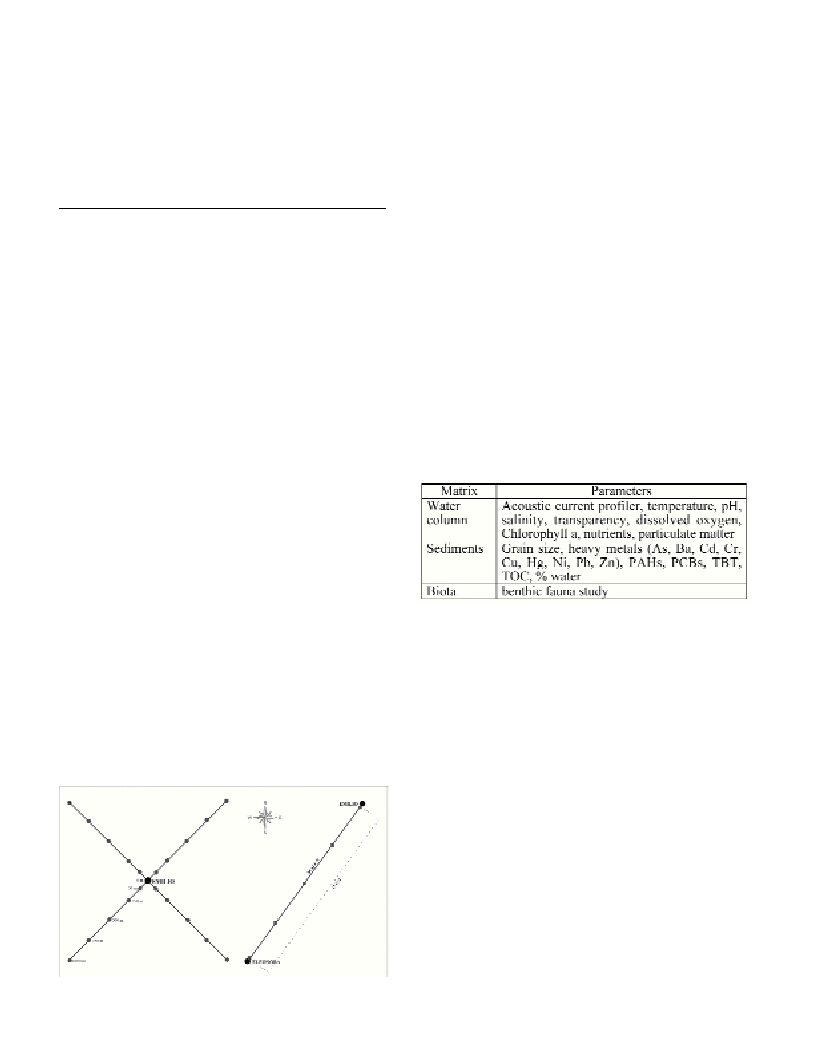METHODOLOGICAL CRITERIA FOR ENVIRONMENTAL MONITORING
OF AN OFFSHORE PLATFORM IN THE CENTRAL ADRIATIC SEA
A.M. Cicero
*
, M. Gabellini, C. Maggi, O. Nonnis, B. Trabucco, C. Virno Lamberti
ICRAM- Via di Casalotti, 300, 00166 Rome, Italy -c.virno@icram.org
Abstract
In order to assess the potential environmental impacts due to the installation of an offshore gas platform, the Central Institute for Marine
Research (ICRAM) worked out a long-term monitoring plan. The plan encompasses multidisciplinary investigations aimed at evaluating
possible biotic and abiotic environmental alterations. The present work reports on the methodological approach used in the study.
Keywords: monitoring, offshore platform, multidisciplinary study
Rapp. Comm. int. Mer Médit., 37,2004
507
The Eni S.p.A - Agip Division delivered, on 1999 to the Italian
Ministry of Environment, the results the environmental impact study
(1) regarding the potential effects on the atmosphere, marine
ecosystem and seascape of the installation of the offshore platform
“Emilio”. The Ministry of Environment, after the evaluation of the
study, gave the authorization to get under way the project.
The project foresaw the installation of the platform “Emilio” and
two connection alongside pipelines (13 km long) to “Eleonora”
platform, in an area of the Central Adriatic Sea (Italy) approximately
29 km from S. Benedetto del Tronto coastline.
The production cycle for the exploitation of the liquid petroleum
gas field is expected to be approximately 10 years, mostly during the
period 2001-2005.
Following the instructions of the Ministry of Environment, the
drilling and production operations were carried out using low-impact
technologies and ensuring that no discharges of produced waters or
others oil-containing wastes were occurring.
In addition, Ministry of Environment requested to perform a long
term monitoring study in accordance with the prescriptions of the
ministerial decree DEC/VIA/5222 (2).
The ENI S.p.A. funded the Central Institute for Marine Research
(ICRAM) to elaborate a monitoring plan to assess the environmental
impacts on the marine ecosystem of the offshore structure.
A four-years monitoring plan was proposed by ICRAM and started
up in December 2002.
A multidisciplinary approach was considered the most suitable to
identify areas where contamination is responsible for ecosystem
degradation and to monitor long-term effects of anthropogenic
activities (3;4).
The proposed monitoring plan, takes into consideration a variety of
biotic and abiotic parameters, encompassing chemical and physical
analyses of water and sediments, benthic fauna analysis, bioaccumula-
tion testing, fish stock assessment and indirect acoustic investigations.
Bearing in mind that a sampling design may play an important role in
environmental impact assessment for detecting significant changes due
to anthropogenic disturbances, an ad hocsampling plan, was proposed.
In the area surrounding the platform a “gradient” sampling design
was elaborated, allocating stations according to distance rather than
using a randomized placement of stations. This sampling design
seemed to be more appropriate to highlight environmental changes
when the point source of disturbance is known (5).
A total of 28 stations were fixed; 21 were located around “Emilio”
along two orthogonal transepts, one of which oriented in the direction
of the NW-SE dominant current, 3 stations were in a presumably
undisturbed site and 4 along the sealines (Fig. 1).
Two sampling surveys were planned for each year, aimed at
collecting data on water column, benthic fauna and sediments; one
was scheduled for the spring season and the second for summer, for
detecting possible natural ?uctuations due to seasonal variability.
In every sampling station, the following parameters have been
selected for the investigation (Tab.1). Mussels (Mytilus
galloprovincialis) bioaccumulation testing was planned in the same
period above mentioned; samples should be collected on the four
platform legs at two different depth (near the water surface and at
–12m, corresponding to the lower limit of the presence of the
organisms). Bioaccumulation results can provide relevant information
on the real environmental risk and bioavalability of some con-
taminants (As, Ba, Cd, Cr, Cu, Hg, Ni, Pb, Zn, PAHs, PCBs, TBT).
Studies on fish population are to be conducted every month in
proximity of the platform. Such investigations should allow to assess
possible impacts of the platform on biodiversity.
The acoustic investigations, consist of a Side Scan Sonar survey to
study the morphological characteristics of the bottom in an area of
4km
2
surrounding the Emilio platform and along the sealines
(13km
2
); in addition, a Multibeam study for a detailed bathymetric
survey (only in the 4 km
2
area), was proposed.
Periodic R.O.V. (Remotely Operated Vehicle) investigations and
scuba diving surveys in the area around the platform were also
planned to monitor the biocoenoses existing along the platform legs.
In relation with the results of the first year, the monitoring plan in
the succeeding years could be revisited.
The proposed methodological approach, based on a long-term multi-
disciplinary study, will allow to collect integrated data, thus providing
environmental information particularly useful for the public adminis-
tration and decision makers for the protection of the marine ecosystem.
References
1-ENI S.p.A., 1999. Progetto Emilio (Concessione B.C3.AS). Studio di
impatto ambientale, 232 p.
2-DEC/VIA/5222, 2000. Ministero dell’Ambiente, 12 p.
3-Chapman P.M., 1990. The Sediment Quality Triad approach to
determining pollution-induced degradation. Sci Tox. Environ. 97 (8): 815-
825.
4-Chapman P.M, Paine M.D. Arthur A.D. and Taylar L.A., 1996. A Triad
study of sediment quality associated with a major relatively untreated
marine sewage discharge. Mar. Poll. Bull. 32 (1): 47-64.
5-Ellis J.I. and Schneider D.C., 1997. Evaluation of a gradient sapmling
design for environmental impact assessment. Environmental Monitoring
and Assessment48: 157-172.
Fig. 1. The proposed sampling design in the “Emilio” area and along the
sealines.
Tab.1. Parameters to investigate on the samples collected during the
two seasonal campaigns.

